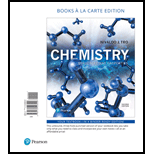
Consider the reaction:
Find the equilibrium concentrations of (A, B, and C for each value of Kc. Assume that the initial concentration of A in each case is 1.0 M and that the reaction mixture initially contains no products. Make any appropriate simplifying assumptions.
a. Kc= 1.0
b Kc= 0.010
c.
Want to see the full answer?
Check out a sample textbook solution
Chapter 15 Solutions
Chemistry: Structure And Properties, Books A La Carte Edition (2nd Edition)
- If a radiation intensity l0 = 2.5x1010 fotones s-1 cm2 causes a dissolución and an absorbance of 0.95 will be recorded. How much incident radiation is absorbed by the music screen?arrow_forwardFrom the causes of the detection of a spectral band of a spectrum obtained by a signal in the gaseous phase that is indicated, you can avoid or minimize those that have their origin in:a) the Doppler effectb) collisionsc) the life time of the excited statearrow_forwarda) Why is it possible that all types of atoms occupy the fundamental energy level?b) What should be the value of the participation function so that it occurs?c) keep in mind that the translational levels of a system are very close, which must be the condition that tenga lugar el condensado de átomos en el fundamental level?arrow_forward
- At the polar moment of Rnm transition, you can confirm thata) nunca can be ser 0b) is a very important magnitude in Raman spectroscopyc) is related to the probability of spectroscopic transactionsd) is related to the selection rulesarrow_forwardIn Fourier transformed spectroscopya) use a very sensitive monocromador systemb) the detection time is inferior to conventional spectroscopiac) the signal is detected depending on the frequencyd) occurs simultaneously at all frequency intervalsarrow_forwardIf a radiation intensity l0 = 2.5x1010 fotones s-1cm2 results in a dissolución, an absorption of 0.95 will be recorded. What is the percentage of incident radiation and transmission?a) 88.88% b) 5% c) 11.22% d) 95%arrow_forward
- Indicate the spectroscopic transmission that requires greater energy radiation. Justification:a) NMR b) vibration c) electronica d) rotationarrow_forwardAfter an induced absorption process of an intensity, there are (without population inversion) transitions between:a) vibrational and rotational levels in the infrared region, we obtainb) vibrational levels exclusively in the infrared regionc) vibrational and rotational levels in the microwave regiond) transitions between nuclear spin levels in the radio frequency regionarrow_forwardIn a spontaneous emission process:a) the ground state population decreasesb) the excited state population decreasesc) the non-radiative component is predominantd) the emitted radiation is coherentarrow_forward
- For a molecule there are 3 energy levels A, B and C, where B is an intermediate energy level between A and C. The A → C transition occurs at 480 nm and the B → C transition occurs at 885 nm. Indicate the wavelength at which the A → B transition will occur.arrow_forwardFor a molecule there are three energy levels: A, B and C. If the transition A → B occurs at 1049 nm and the transition B → C occurs at 885 nm, we can say that the wavelength of the transition A → C will occur at approximately:a) 164 nm b) 1934 nm c) 480 nm d) 967 nmarrow_forward: Naming the Alkanes a) Write the IUPAC nomenclature of the compound below b) Draw 4-isopropyl-2,4,5-trimethylheptane, identify the primary, secondary, tertiary, and quaternary carbons. c) Rank pentane, neopentane and isopentane for boiling point. pentane: H3C-CH2-CH2-CH2-CH3 neopentane: CH3 H3C-C-CH3 isopentane: CH3 CH3 H3C-CH2-CH-CH3arrow_forward
 Chemistry: The Molecular ScienceChemistryISBN:9781285199047Author:John W. Moore, Conrad L. StanitskiPublisher:Cengage Learning
Chemistry: The Molecular ScienceChemistryISBN:9781285199047Author:John W. Moore, Conrad L. StanitskiPublisher:Cengage Learning Chemistry & Chemical ReactivityChemistryISBN:9781337399074Author:John C. Kotz, Paul M. Treichel, John Townsend, David TreichelPublisher:Cengage Learning
Chemistry & Chemical ReactivityChemistryISBN:9781337399074Author:John C. Kotz, Paul M. Treichel, John Townsend, David TreichelPublisher:Cengage Learning Chemistry & Chemical ReactivityChemistryISBN:9781133949640Author:John C. Kotz, Paul M. Treichel, John Townsend, David TreichelPublisher:Cengage Learning
Chemistry & Chemical ReactivityChemistryISBN:9781133949640Author:John C. Kotz, Paul M. Treichel, John Townsend, David TreichelPublisher:Cengage Learning ChemistryChemistryISBN:9781305957404Author:Steven S. Zumdahl, Susan A. Zumdahl, Donald J. DeCostePublisher:Cengage Learning
ChemistryChemistryISBN:9781305957404Author:Steven S. Zumdahl, Susan A. Zumdahl, Donald J. DeCostePublisher:Cengage Learning Chemistry: An Atoms First ApproachChemistryISBN:9781305079243Author:Steven S. Zumdahl, Susan A. ZumdahlPublisher:Cengage Learning
Chemistry: An Atoms First ApproachChemistryISBN:9781305079243Author:Steven S. Zumdahl, Susan A. ZumdahlPublisher:Cengage Learning





